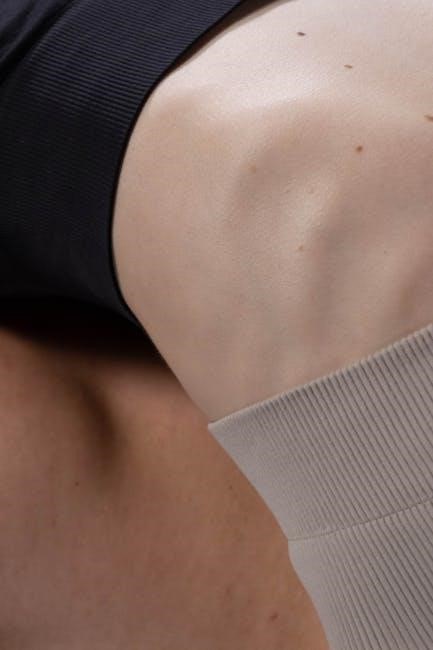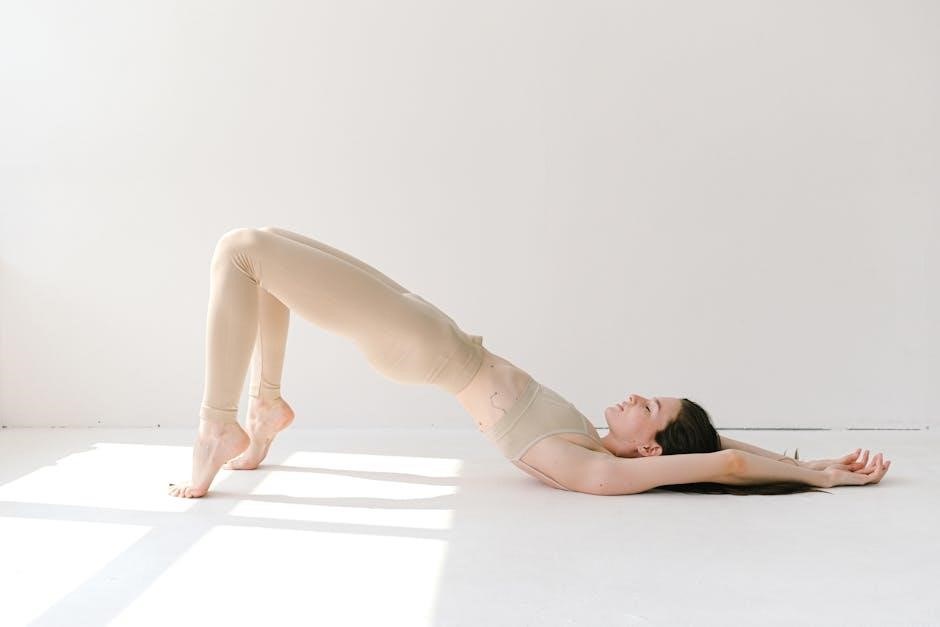Understanding the Gluteus Medius
The gluteus medius‚ a key muscle connecting thigh and pelvis‚ is often overlooked despite its crucial role in movement‚ stability‚ and overall functional fitness.
What is the Gluteus Medius?
The gluteus medius is a vital muscle located in the hip‚ residing within the gluteal muscle group alongside the gluteus maximus and minimus. It originates from the outer surface of the ilium and inserts along the greater trochanter of the femur – essentially connecting your thighbone to your pelvis. This strategic positioning allows it to powerfully abduct and internally rotate the hip‚ crucial for maintaining pelvic stability during single-leg stance‚ like walking or running.
Often described as a key stabilizer‚ the gluteus medius prevents the pelvis from dropping on the unsupported side when you’re moving. It’s a significant powerhouse‚ contributing to everything from explosive movements to safe‚ efficient locomotion. Ignoring its health can lead to various issues‚ highlighting the importance of understanding and caring for this often-underappreciated muscle.
Importance of the Gluteus Medius
The gluteus medius plays a pivotal role in maintaining proper biomechanics and preventing injuries throughout the body. Its primary function – stabilizing the pelvis – directly impacts the alignment of the hips‚ knees‚ and ankles. A weak or inhibited gluteus medius can lead to a cascade of problems‚ including lower back pain‚ hip impingement‚ and even knee issues.
Beyond injury prevention‚ a strong gluteus medius enhances athletic performance. It’s essential for runners‚ skiers‚ and climbers‚ enabling efficient movement and power transfer. It supports everyday activities like walking‚ standing‚ and climbing stairs. Essentially‚ it’s a foundational muscle for functional movement‚ contributing to overall strength‚ balance‚ and stability‚ making it a cornerstone of physical well-being.

Why Stretch the Gluteus Medius?
Stretching this muscle improves mobility‚ alleviates tightness‚ and enhances daily movement‚ preventing pain and optimizing performance for activities like running and climbing.
Symptoms of a Tight Gluteus Medius
Recognizing the signs of a tight gluteus medius is the first step towards addressing discomfort and restoring optimal movement patterns. Common symptoms include experiencing pain specifically on the outside of the hip‚ often intensifying with activity or prolonged sitting. Individuals might also notice difficulty moving freely‚ a general feeling of tightness‚ particularly noticeable in the mornings‚ and limitations in range of motion during everyday tasks.
Furthermore‚ a tight gluteus medius can contribute to imbalances in the lower body‚ potentially leading to pain in the lower back‚ knees‚ or even ankles. You may feel a distinct pressure or strain on this area during walking‚ standing‚ or even simply attempting to sit comfortably. Ignoring these signals can exacerbate the issue and hinder your ability to perform daily activities without discomfort. Early intervention through targeted stretching can significantly alleviate these symptoms and prevent further complications.
Impact on Movement and Daily Activities
A compromised gluteus medius significantly impacts a wide range of movements and daily activities. This muscle is vital for stabilizing the pelvis during walking‚ running‚ and even standing on one leg. When tight or weak‚ it can lead to altered gait patterns‚ causing inefficient movement and increased stress on other joints. Simple tasks like climbing stairs‚ getting in and out of a car‚ or even maintaining proper posture can become challenging and uncomfortable.
For athletes‚ a dysfunctional gluteus medius can hinder performance and increase the risk of injury. Runners may experience altered biomechanics‚ leading to knee pain or IT band syndrome. Skiers and climbers require strong gluteal muscles for stability and control‚ and tightness can compromise their technique and safety. Ultimately‚ addressing gluteus medius issues is crucial for restoring functional movement and improving overall quality of life.

Effective Gluteus Medius Stretches
Several targeted stretches can effectively address gluteus medius tightness‚ improving hip mobility and alleviating discomfort‚ enhancing performance and daily function.
Standing Gluteus Medius Stretch
To perform a standing gluteus medius stretch‚ begin by standing tall with your feet hip-width apart. Gently cross one ankle over the opposite knee‚ forming a figure-four shape. Maintaining a straight back‚ slowly bend at the hips as if sitting back into a chair‚ feeling a stretch along the outer hip of the bent leg.
Hold this position for approximately 30 seconds‚ ensuring you maintain a neutral spine and avoid rounding your back. You should feel the stretch primarily in the gluteus medius of the crossed leg. For a deeper stretch‚ gently press down on the bent knee. Repeat this stretch on the other side‚ ensuring equal time and attention is given to both legs.
This stretch is excellent for runners and individuals experiencing tightness on the outside of their hip‚ effectively targeting the gluteus medius muscle. Remember to breathe deeply throughout the stretch to enhance relaxation and improve flexibility.
Supine Gluteus Medius Stretch (Lying Down)
Lie comfortably on your back with your knees bent and feet flat on the floor. Cross your right ankle over your left knee‚ creating that familiar figure-four position. Gently pull your left thigh towards your chest‚ interlacing your fingers behind it or over the shin. You should feel a stretch in the outer hip of your right leg – this targets the gluteus medius.
Hold this stretch for around 30 seconds‚ breathing deeply and relaxing into the sensation. Avoid pulling forcefully; the stretch should be gentle and controlled. Repeat on the opposite side‚ crossing your left ankle over your right knee and pulling your right thigh towards your chest.
This supine stretch is a great option for those who find standing stretches challenging‚ offering a comfortable and effective way to release tension in the gluteus medius.
Seated Gluteus Medius Stretch
Find a chair or sit comfortably on the floor. Begin by extending your right leg straight out in front of you‚ keeping your foot flexed. Bend your left knee and place your left foot flat on the floor‚ close to your right thigh. Gently lean forward from your hips‚ keeping your back straight‚ until you feel a stretch in the outer hip of your right leg.
Avoid rounding your back or forcing the stretch. Hold this position for approximately 30 seconds‚ focusing on deep‚ even breaths. Repeat on the opposite side‚ extending your left leg and bending your right knee.
This seated variation is accessible and effective‚ making it ideal for incorporating into your daily routine‚ especially during prolonged periods of sitting.

Gluteus Medius Stretches for Specific Activities
Targeted stretches benefit runners‚ skiers‚ and climbers by addressing unique demands‚ enhancing performance‚ and preventing injuries related to this vital muscle group.
Stretches for Runners
Runners frequently experience gluteus medius tightness due to repetitive motion and impact. Incorporating specific stretches into your routine can significantly improve running efficiency and reduce injury risk. A standing gluteus medius stretch‚ performed by crossing one ankle over the opposite knee and gently leaning forward‚ targets the muscle effectively.
Additionally‚ the supine (lying down) stretch‚ where you bring your knee towards your chest while keeping your foot flexed‚ provides a deeper stretch. Focus on feeling the stretch in the outer hip and gluteal region. Prioritize consistent stretching‚ both as part of your warm-up to prepare the muscles for activity and as a cool-down to promote recovery and flexibility; Remember to hold each stretch for 30 seconds and repeat 2-3 times on each side. Addressing gluteus medius tightness is paramount for optimal running performance and long-term joint health.
Stretches for Skiers and Climbers
Skiers and climbers demand significant stability and control from their gluteus medius‚ making it prone to tightness and strain. The seated gluteus medius stretch‚ achieved by sitting with legs extended and gently pulling one heel towards the opposite glute‚ is particularly beneficial. This stretch helps counteract the inward rotation often experienced during these activities.
Furthermore‚ a modified supine stretch‚ where you gently rotate your thigh outwards while bringing your knee towards your chest‚ can target deeper fibers. Regularly performing these stretches enhances hip stability‚ crucial for navigating uneven terrain and maintaining balance. Prioritize stretching before and after activity to prepare muscles and aid recovery. Holding each stretch for 30 seconds‚ repeated 2-3 times per leg‚ will maximize benefits and minimize injury risk in these demanding sports.

Addressing Gluteus Medius Tears & Pain
A gluteus medius tear can severely impact mobility; stretching‚ when appropriate and guided by a professional‚ becomes a vital component of the recovery process.
Recognizing a Gluteus Medius Tear
Identifying a gluteus medius tear requires attention to specific symptoms; Pain on the outer hip is a primary indicator‚ often radiating down the thigh. Difficulty walking‚ particularly a noticeable limp‚ frequently develops as the tear compromises stability. Simple actions like standing on one leg can become challenging‚ revealing weakness in the affected side.
A feeling of instability‚ as if the hip might give way‚ is also common. The pain may worsen with activities like climbing stairs or prolonged standing. It’s crucial to differentiate this pain from other hip conditions. While a stretch PDF can offer relief for tightness‚ a tear necessitates professional diagnosis. Ignoring these signs can lead to chronic pain and further complications‚ hindering daily activities and athletic performance. Seeking medical evaluation is paramount for accurate assessment and appropriate treatment.
Stretching as Part of Recovery
Following a gluteus medius tear‚ stretching plays a vital‚ yet carefully managed‚ role in recovery. Initially‚ gentle stretches‚ guided by a physical therapist‚ are crucial to restore range of motion and prevent stiffness. A gluteus medius stretch PDF can provide visual guidance‚ but professional oversight is essential. Avoid aggressive stretching that exacerbates pain; focus on controlled‚ pain-free movements.
As healing progresses‚ incorporating more dynamic stretches can improve muscle flexibility and function. Stretching helps to re-establish proper muscle length-tension relationships‚ supporting optimal hip mechanics. It’s important to remember stretching is part of a comprehensive rehabilitation program‚ alongside strengthening exercises and activity modification. Patience and consistency are key to a successful recovery‚ preventing re-injury and returning to full activity levels.

Finding Gluteus Medius Stretch PDFs
Numerous online resources offer gluteus medius stretch PDFs‚ providing visual guides for effective routines; however‚ verifying the source’s credibility is paramount for safety.
Where to Download Reliable PDFs
Locating trustworthy gluteus medius stretch PDFs requires discerning sources. Reputable physiotherapy websites and clinics frequently offer downloadable guides created by qualified professionals. Look for PDFs from organizations dedicated to sports medicine or rehabilitation‚ as these are more likely to contain accurate and safe exercises.
University athletic departments and certified personal training platforms also provide valuable resources. Avoid PDFs from unknown or unverified websites‚ as the information may be inaccurate or even harmful. Always check for credentials and author information before trusting a guide. Websites like those of established fitness magazines‚ when authored by qualified experts‚ can also be reliable. Prioritize PDFs that include clear instructions‚ illustrations‚ and modifications for different fitness levels. Remember‚ a good resource will emphasize proper form and caution against pushing through pain.
What to Look for in a Good PDF Guide
A superior gluteus medius stretch PDF will prioritize clarity and safety. It should feature detailed‚ step-by-step instructions accompanied by high-quality illustrations or photographs demonstrating correct form. Look for guides that explain the muscle’s function and the benefits of stretching it‚ providing context for the exercises.
Crucially‚ a good PDF will offer modifications for varying fitness levels and address potential limitations. It should emphasize listening to your body and stopping if you experience pain. The guide should also clearly differentiate between discomfort and injury. Bonus features include warm-up recommendations and cautions about contraindications. Avoid PDFs lacking author credentials or those promoting overly aggressive stretching techniques. A reliable guide will empower you to stretch effectively and safely‚ promoting long-term gluteus medius health.

Integrating Stretches into Your Routine
Regularly incorporating gluteus medius stretches‚ whether during warm-ups or cool-downs‚ enhances mobility‚ supports athletic performance‚ and prevents potential muscle imbalances.

Warm-up vs. Cool-down Stretching

Distinguishing between warm-up and cool-down stretching for the gluteus medius is vital for maximizing benefits and minimizing injury risk. Before activity‚ dynamic stretches – controlled movements through a range of motion – prepare the muscle for exertion. Think leg swings or hip circles; these increase blood flow and flexibility.
Conversely‚ cool-down stretching involves static stretches‚ holding a position for 20-30 seconds‚ after exercise. This helps lengthen the muscle‚ improve flexibility‚ and reduce post-exercise soreness. Focusing on static gluteus medius stretches post-workout aids recovery and prevents tightness. A PDF guide can illustrate proper form for both types‚ ensuring you’re optimizing each stretching session for its intended purpose. Prioritizing the correct type at the right time will significantly improve your results.
Frequency and Duration of Stretches
Determining the ideal frequency and duration of gluteus medius stretches depends on your activity level and individual needs. For general maintenance‚ stretching 2-3 times per week is beneficial‚ holding each stretch for 20-30 seconds. Athletes or individuals experiencing tightness may benefit from daily stretching.
A comprehensive gluteus medius stretch PDF will often outline suggested routines based on different fitness goals. Consistency is key; short‚ regular sessions are more effective than infrequent‚ lengthy ones. Listen to your body and avoid pushing beyond a comfortable range of motion. Remember‚ the goal is to improve flexibility and reduce tension‚ not to cause pain. Prioritize quality over quantity‚ and a well-designed PDF can guide you towards optimal results.

